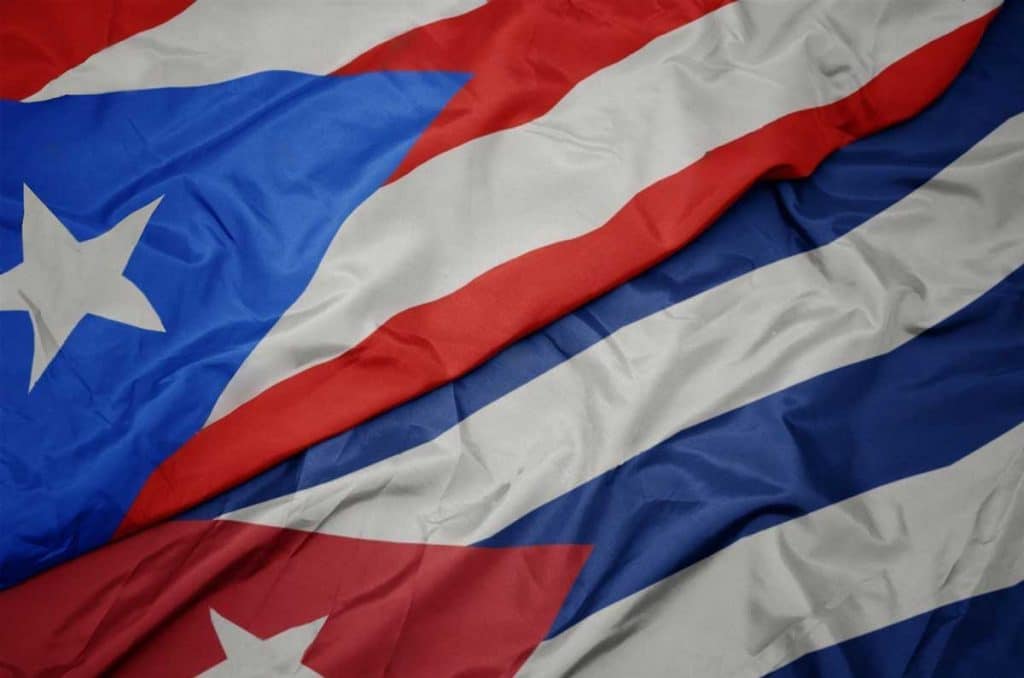Why Do the Flags of Cuba and Puerto Rico Look Alike? It’s No Coincidence

Two of the most popular vacation spots in the Caribbean are the islands of Puerto Rico and Cuba.
The history of Cuba and Puerto Rico are linked. Both islands were once Spanish territories before being turned over to the United States. In 1898, Puerto Rico became a U.S. territory, and in 1902, Cuba became a protectorate. Both islands housed U.S. military installations, which remained there during the Cold War.
However, each nation has a distinctive flag design that is well known around the world. But everyone is curious as to why the designs of both nations are nearly identical. This immediately brings up the history of the two nations.
Narciso López, a pro-independence refugee living in New York, created the Cuban flag in 1849.
A commission of exiles in New York chose the design of the Puerto Rican flag in the mid-19th century.
It is not known with certainty who was the creator of the Puerto Rican flag, but the similarities between the two flags demonstrate how closely related the independence movements of Cuba and Puerto Rico were. These movements developed almost in parallel, from the relative safety of New York City, a city that welcomed the independence revolutionaries of the West Indies.
The Cuban Revolutionary Party, founded by José Mart, Cuba’s national hero, to secure Cuban independence, had a Puerto Rican committee.

The Puerto Ricans, in New York, in 1895, agreed to use the same pattern as the Cuban flag, but with the colors reversed.
The Puerto Rican flag has a blue triangle with a white star in the center of the triangle. It has red and white stripes.
The Cuban flag has blue and white stripes, with a white star in the center of the red triangle.
🇵🇷 The flag of Puerto Rico
With the promulgation of the Constitution of the Commonwealth on July 25, 1952, the flag of Puerto Rico became official. It flies next to the American flag, the Stars and Stripes.
The design of the Commonwealth flag represents the strong ties that united Cuban and Puerto Rican patriots in the 19th century.
On December 22, 1895, the flag of Puerto Rico was raised for the first time.
A political organization affiliated to the Cuban Revolutionary Party, formed by 59 Puerto Ricans, under the leadership of Julio J. Henna, decided the creation of the flag of independent Puerto Rico. It was all decided at a meeting at Chimney Corner Hall in Manhattan, New York, a meeting to promote the independence of Cuba and Puerto Rico from Spanish authority.

The flag quickly became a recognizable national emblem for Puerto Ricans.
The flag was adopted by the Nationalist Party in the 1930s after becoming the symbol of resistance to the U.S. invasion of 1898. It was formally approved as the flag of Puerto Rico on July 25, 1952, when the island joined the U.S. as a Commonwealth.
The flag of Puerto Rico consists of five stripes, three red and two white, alternating. A solitary white five-pointed star perched on a blue triangle is placed to the left of the flag.
What is the meaning of the Puerto Rican flag?
Here is an explanation of the symbology. The three sides of the equilateral triangle represent the three branches of the republican government, while the white star signifies the Commonwealth of Puerto Rico.
The three red stripes are a representation of the blood of the executive, legislative and judicial branches. The two white stripes represent human rights and individual freedom and serve as a constant reminder of the need to protect a democratic system of government.
🇨🇺 The Cuban flag
In the 19th century, specifically in the year 1849, the Cuban flag was created. The Constituent Assembly of Guáimaro adopted it, 20 years later.
Since 1902, it has served as the national flag of Cuba, representing the independence of the island nation.

A white star, a red triangle, three blue stripes and two white stripes compose the flag. It is a pattern with a clear Masonic influence.
Cuban patriots of the 19th century, many of whom were Masons, were attracted to the symbolism of the triangle. It represents the majesty and power of the Great Architect of the Universe, as well as providence or destiny. The three sides of the triangle, of equal size, represent liberty, equality and fraternity, which is a Masonic maxim and a key component of the French Revolution.
In a more political context, the equilateral triangle represents the three powers that should form a republic: the executive, the legislature and the judiciary; this is known as the theory of “tripartite power” expounded by Charles Louis de Secondat, Baron de Montesquieu.
The original meaning, still applicable today, was that the white star in the center of the red triangle represented power, beauty, knowledge, solidarity and morality.
The numbers 3, 5 and 7 -also symbolic- are included in the Cuban flag.
The three are the blue stripes symbolizing perfect harmony; the five is the sum of the blue and white stripes; and the seven, which the Greeks and Jews considered the number of the divine, is the sum of all the components when the stripes, the triangle and the star are added.
According to other interpretations, the crimson tint of the triangle represents the blood shed during Cuba’s liberation struggles. However, the Cuban flag was created by Miguel Teurbe Tolón before the war for the country’s independence, so the crimson color of the triangle is not associated with spilled blood, but with the idea of Providence.

To be clear, flags and other such symbols do not always have the same meaning and it can change over history and time. An example of this is the situation of the Cuban flag.
The Cuban flag, commonly known as the “lone star flag”, now has a connotation that differs from its original meaning due to Masonic interpretation, design and somewhat annexationist intentions.
According to this explanation, the three blue stripes represent the three divisions of colonial times that divided Cuba: West, Center and East.
According to this perspective, the intermingling white stripes represent the values of morality and purity of the Cubans.
The red triangle represents the blood shed by Cuban nationalists and independence fighters defending the principles of equality, liberty and fraternity. The white five-pointed lone star represents the freedom and independence of the Republic, the sovereign and the people.
Miguel Teurbe Tolón (1820-1857) based the design of the Cuban flag and coat of arms on concepts proposed by the Venezuelan patriot Narciso López.
For Cuban historiography, at least most of its representatives, López is considered an annexationist who wished to unite Cuba to the incipient United States.

Narciso López and other heroes swore before the Cuban flag to fight and give their lives to free Cuba from Spanish rule. Before being assassinated by the Spanish in Havana on September 1, 1851, using the horrible garrote vil, López led as many as five attempts to liberate the island.

Confusion about the flags
Puerto Rico and Cuba do not fly the same flag, although many may be confused by the sight of them.
You might be confused if you are not Puerto Rican or Cuban. However, despite their similarities, the flags of Cuba and Puerto Rico are not the same.
The shapes are the same and the elements are similarly placed, but the distribution of colors differs.
The equilateral triangle of the Puerto Rican flag is blue, while that of the Cuban flag is red. The colors of the stripes are also reversed: Puerto Rico’s stripes are red and white, while Cuba’s are blue and white.
The place of creation of the respective flags of both countries also contributes to their similarity. The flag of Puerto Rico was created in New York, as was the flag of Cuba.
The Cuban Revolutionary Party (PRC), which included a Puerto Rican section, was founded by José Martí, leader of an independence movement that sought to liberate Puerto Rico and not only Cuba. Achieving Puerto Rican independence was one of the guiding principles of Martí’s party.
Even so, it is not clear when the Puerto Rican flag was designed or who designed it.
There is historiographical discussion surrounding it, as numerous Puerto Rican nationalists claim to have created the flag. In the end, it is probably a product of collective thinking.
The Puerto Rican flag first flew in Puerto Rico on March 24, 1897, during the Yauco independence attempt, according to historians.
The metaphor that “Cuba and Puerto Rico are the two wings of the same bird” is reinforced by the similarity between the national flags of Cuba and Puerto Rico.







And what about Philiphines? Also Spain colony, named after Spain’s king Philip. Similar basic form of flag.
You’re absolutely right, and I appreciate your addition. The flag of the Philippines does indeed share a common history and some similarities with those of Cuba and Puerto Rico due to their shared past as Spanish colonies.
The Philippine flag is different in its symbolism, though. While the Cuban and Puerto Rican flags feature stripes and a single star within a triangle, the Philippine flag uses a white equilateral triangle, a golden sun, and three stars. The sun represents freedom, the triangle symbolizes equality and the fraternal principles of the French Revolution, and the stars stand for the three main geographical regions of the country: Luzon, Visayas, and Mindanao. The use of red, white, and blue can also be seen as a common theme in all these flags, further pointing to their shared historical ties.
Interestingly, the Philippine flag also has a unique feature. It can be displayed with the red stripe up in times of war and blue stripe up in times of peace.
Thank you for bringing up this point, as it enriches our understanding of how the histories of these nations are interwoven and reflected in their flags.